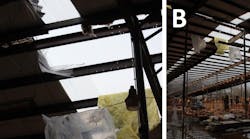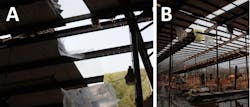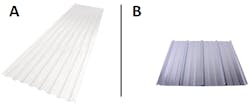An out-of-state roofing contractor was hired to remove and replace roofing and insulation as a part of a tobacco warehouse renovation project. A work crew of three roofers and one foreman were on site for approximately three weeks and were in the process of installing the new rolled fiberglass insulation and corrugated metal roofing materials onto a warehouse roof. The original skylights were being used and not replaced.
The crew arrived at the worksite at 9:00 a.m. on Friday, Dec. 11, 2015. They had been using a Genie S-45 boom lift to access the roof and transfer roofing materials. Approximately three hours after arriving, the three roofers were positioned on the roof—near the roof’s peak. The foreman was located at the ground level. None of the roofers were wearing fall protection, and the nearby skylights were not guarded.
The victim,a 25-year-old male roofer and father, was stretching roofing insulation near the peak of the roof when the insulation tore, causing him to lose his balance. He stepped forward onto a clear fiberglass skylight in an attempt to regain balance, causing the skylight to break. He fell approximately 30 ft. to the concrete below, fatally striking his head. He was pronounced dead at the scene by the coroner.
The incident took place inside a former tobacco warehouse. The floor was littered with old insulation that had been removed and the new rolls of fiberglass insulation that were to be installed. The 1:12 pitch roof was being constructed of corrugated sheets of metal and had corrugated fiberglass skylights running through. There was a tractor and van stored inside the building. When the victim fell, he landed on the concrete surface below in a large puddle of water. The foreman witnessed the victim falling and called for emergency medical services. The victim was pronounced dead at the scene at 12:23 p.m. by the coroner.
Lack of Training, Personal Protective Equipment Use
The other roofers on the scene, including the foreman, stated that despite fall protection being available, they did not use it on the day of the incident and had no training on how to wear it properly. The foreman was working on the roof with the roofers off and on that day and the lack of personal fall arrest systems being worn was readily visible to onlookers. The roofers also stated that they had never received any type of worker safety training except lift operation training since being hired by the employer, as required by federal and state OSHA regulations.The use of the boom lift also required personal fall arrest systems, which were not used during boom operation.
As a result of this tragic incident and the investigation, Kentucky FACE made the following recommendations for the prevention of future similar incidents:
- A job hazard analysis should be performed by a trained, competent person, before beginning a job. 29 CFR 1910.132(d)(2)
“Job Hazard Analysis”. Occupational Safety and Health Administration. [PDF].
- Workers should always use personal fall protection when exposed to a vertical drop of 6 ft. or more.
“Duty to have fall protection, 29 CFR 1926.501(b)(2)”. Occupational Safety and Health Administration”.
- All employees expected to work from heights of 6 ft. or more should receive training on fall protection use prior to beginning such work.
- Employers and forepersons should enforce worker safety policies and procedures that, at a minimum, adhere to federal OSHA regulations.
Kentucky FACE uses the facts gathered from investigations to formulate and disseminate injury prevention strategies, with the hope of preventing similar future incidents. The program does not determine fault or blame and does not enforce compliance with state or federal occupational safety and health standards. Kentucky FACE is grant-funded by the National Institute for Occupational Safety and Health (NIOSH) and operates from the Kentucky Injury Prevention and Research Center (KIPRC) at the University of Kentucky. KIPRC is a bona fide agent for the Kentucky Department for Public Health.


